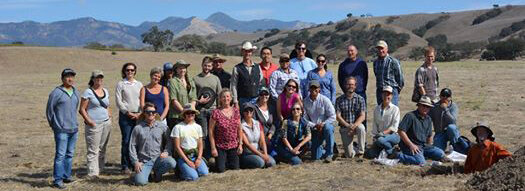Local Ranch and Conservation Agencies Receive California Healthy Soils Award
The Community Environmental Council (CEC), Cachuma Resource Conservation District (CRCD), and Ted Chamberlin Ranch have been awarded a major statewide grant to scale-up and expand a regenerative agriculture research pilot underway on the Chamberlin Ranch in Los Olivos.
Drawing Down Carbon
The award comes from the California Department of Food and Agriculture 2017 Healthy Soils Program, which aims to build soil carbon. This practice effectively pulls excess carbon from the air and stores it instead in the soil – reducing agricultural greenhouse gas (GHG) emissions.
Sigrid Wright, CEO/Executive Director of CEC, hailed the grant as "a huge win for our community," commenting on the urgent need to seek ways to rapidly drawdown excess carbon and mitigate the worst impacts of climate change, which recent disastrous events in our County have made even more relevant.
Collaborating for Climate Solutions
The collaborative project between CEC, CRCD and Chamberlin Ranch is officially titled "Scaling Up Carbon Farming on Central Coast Rangelands," and assesses the feasibility of compost application on grazed rangeland to increase soil health and mitigate greenhouse gas emissions. This site is one of a dozen from around the state of California, and has been selected to demonstrate that simple land management tools can yield a wide range of soil and water benefits, while at the same time capturing excess carbon from the atmosphere to mitigate climate change.
Together with a large, diverse set of local and international partners, CEC, CRCD and the Chamberlin Ranch will use the grant over the next three years to 1) integrate compost application into a working ranch, 2) garner support for wide-scale adoption of carbon farming practices on agricultural land, and 3) show the potential for the agricultural sector to become both more resilient in the face of climate change and a leader in climate change mitigation.
One element of the test pilot is identifying the best methods for helping soil capture the maximum amount of carbon and organic matter. Anna Olsen, who directs CRCD, notes that when soil is richer in carbon it creates more resilient vegetation and healthier produce, "so it’s truly a win for people, the land, and the environment.”
Kicking Off the Project
This month CEC, CRCD, Ted Chamberlin Ranch and its partners held a kick-off event. Dignitaries – including Senator Hannah-Beth Jackson and Santa Barbara County Supervisor Joan Hartmann – ranchers and other stakeholders gathered at the Ted Chamberlin Ranch to learn about the grant program and other opportunities to scale up carbon farming practices.
Over the next three years, multiple field days will be held at the Ranch to bring diverse awareness to these opportunities, setting the groundwork for large-scale adoption of carbon farming practices in Santa Barbara County and beyond. The initial phase of work on Ted Chamberlin Ranch was sparked in part by work with the Santa Barbara County Food Action Plan. The initial research phase was funded by the USDA Natural Resources Conservation Service and the Santa Barbara Foundation’s LEAF Initiative.
